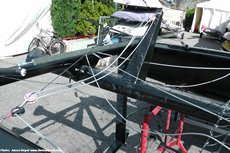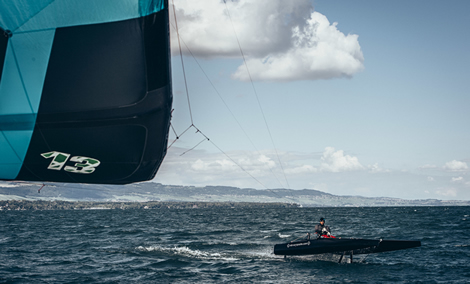
Alinghi crew go foiler kiting
Thanks to the last America’s Cup and 10 years of foiling Moths…10 years!...foil-born boats and their development are no longer solely the preserve of AYRS-card carrying, crazy haired former physics professors. During July on Lake Garda the inaugural Foiling Week was held, featuring a gathering of the foiling specialists from all over the globe along with a unique and frankly amazing collection of craft, most inspired by last year’s airborne antics of the AC72s.
One craft that in particular caught our eye in Malcesine was the NTFM Project (standing for ‘non ti fermi mai’ or ‘don’t you ever stop…’) as much for the radical nature of the vessel as for the heavyweights behind it – Nils Frei and Yves Detrey, two of the longest serving members of Ernesto Bertarelli’s Alinghi crew, both integral to the present Alinghi Extreme 40 and D35 campaigns but also previously on the Swiss team’s Cup boats.
“It is not an Alinghi project, but we talk with Ernesto about it,” says Frei. “He is well informed about what we’re doing because we are still 100% Alinghi. This is just for fun.”
Frei and Detrey started work on the project around three years ago, but as very much a part time affair when they were back home in Switzerland between events.
The present NTFM Project is a catamaran, based on modified A-Cat hulls. However most evident it is unique foil arrangement. This initially doesn’t look like it is going to suit a catamaran. It doesn’t have the L’Hydroptere-style straight foils that hinge below the main beam attachment to the hulls as used on the Whites Dragons foiling cat, which when lowered to around 45⁰ cause the boat to foil, but when raised allow the boat to be sailed in conventional low rider mode. Nor does it have the two-Moths-strapped-together-to-form-a-catamaran set-up of the Italian S.9 singlehander, nor the AC72-style configuration of J-foils and T-foil rudder, a modified version of which is found on the GC32.
Instead NTFM Project has a central tube that runs fore and aft along the centreline of the boat. This tube rotates within bearings mounted in substantial brackets fitted beneath the two crossbeams. Attached to the tube immediately forward of the main crossbeam is a Δ shaped foil (imagine a Moth T-foil only with vertical struts, attached to each end of the foil, rather than a single one in the middle). At the forward end of the tube, roughly 2m ahead of the main beam, is a wand that mechanically operates the trim tab on the back of the lifting foil – like the standard Moth set-up. The tube in its entirety is rotated via a lever arm mounted on the tube just forward of the aft beam, that points upward and is controlled via a purchase system running laterally across to the hulls.
The other significant thing about NTFM Project is that it doesn’t have a mast and, as the photos portray, it is kite powered. Rather precariously, the driver – usually Yves Detrey – sits in the middle of the boat from where he uses two foot pedals to steer freeing up his hands to trim the kite and to cant the foil.
Frei explains the principle of the foil. “We can actively cant the foil, so we can make it produce the lift we want. But when we put it sideways it also provides the necessary side force, so it becomes quite efficient foiling upwind which is something not many foiling boats do well, apart from Moths. So this is a bit like what the Moths are doing when they heel windward sailing upwind.”
The boat is very much a work in progress and at the time of Foiling Week one of the significant changes Frei and Detrey had already made to the boat was the rudder arrangement. Initially the boat was fitted with a single T-foil rudder at the back of the tube which rotated in line with the main foil. “That was…‘interesting’,” admits Frei. “It was very efficient upwind, but it was not that stable.” They have now replaced this arrangement with a more standard twin T-foil rudder configuration which is much more stable.
With the twin rudder set-up, Frei says the boat manoeuvred well, they can tack and gybe it, just about. “It is not easy to achieve, but it is manageable. Yves need some more hours, but it is coming.”
However since Foiling Week they have also tried once again to see if they can get the single rudder set-up to work – and according Detrey that is now finally showing some positive results.
The hulls currently being used on NTFM Project came from an A-Cat Frei and Detrey found abandoned, which they have since chopped up and modified to suit their requirements. The cat provides a stable platform prior to the foil kicking in, but looks a little ungainly when it lifts clear of the water.
According to Frei they typically use a kite of 10-15sqm depending on the conditions, or slightly larger than a kiteboarder would use. In terms of how it is used, the kite has one side of it sheeted off and the other trimmed via a traveller arrangement mounted on the front cross beam.
As with all kite powered boats – one of the great benefits compared to that of conventionally rigged boats, is that the issue of heel moment is simply eliminated. While standard mast and sails will always cause a yacht to incline, a kite simply pulls in the direction of the kite from wherever the kite is attached to the boat. As Frei puts it: “You can always sail the boat flat, so you stay in the middle and put the kite to leeward and most of the time it gives you just the right force to lift both hulls at the same time.”
The kite is doubly advantageous for a foiler as it provides vertical lift of its own and this allows the boat to ‘lift off’ earlier, in the case of NTFM Project, in as little as 6-7 knots of wind.
The objective of NTFM Project says Frei is not speed, it is more confirming the different aspects of the concept can be made to work. “We want to optimise VMG sailing with the kite and to be able to fly upwind and downwind, not to beat speed records – that would be another configuration.
“It is to prove the concept and we are quite confident that a lot of ideas about how the foil works and how the kite brings stability to the boat – they are working quite nicely. It is obviously not easy to sail it alone as you have a lot of things to do like steer with your feet, handle the kite, cant the foil and move the traveller, but that is just on this size of boat. You can imagine having a bigger boat with the same concept and maybe having someone doing the traveller and the kite, someone else doing the canting of the foil and someone steering – that would be very different.
"The good thing about the concept is that you could imagine scaling it up without too many problems. The Moth – I love it and it’s great, but I think it works very well at that size. If you go bigger it is a little bit different. With this, if you go bigger you should find it is just the same principle: You still don’t have that heeling force that you have with a normal rig.”
Ntfm Project, Non ti fermi mai from Christophe Margot on Vimeo.
 |
 |
 |
 |
 |
 |
In trials since Foiling Week Yves Detrey reports that the boat behaves well when the wind is steady. It readily foils and he has managed foiling gybes. When it gets tricky is when there are gusts or shifts, with so much for one person to do on board. “The boat will tack, but every time we have to stop and readjust everything. But this is just a test platform. Remember the first foiling Moth when it was launched? That’s how we look today.”
So where next for the NTFM Project? Frei and Detrey are keen to graduate up to a bigger boat, but Detrey says that this won’t necessarily have the same catamaran configuration. They used the cat initially because it was stable but all existing boats they might try are all set-up to counter the heeling force of a mast. He also observes: “This is the beauty of the kite – there’s no structure needed for the effort of the mast, so the boat can be a lot lighter...
“We have ideas to improve the foils, the control mechanism, and a bigger boat would not look like anything you have seen before, just because we have to think so differently. Maybe a mix between a Moth, a spider, and a cat! The bottom line is that we believe there is so much to improve in the concept on/in the water or up in the air, that eventually the VMG performance will be spectacular.”
And so yet another avenue of foil-born yachting opens up…
More images from Loris von Siebenthal / www.myimage.ch
 |
 |
 |
 |
 |
 |
 |
 |
 |
|
 |
 |













Latest Comments
Add a comment - Members log in